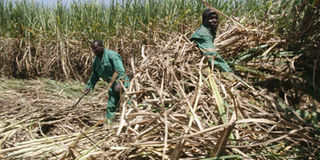OPANGA: State must come to the rescue of cane farmers

Sugar cane farmers harvest cane in a plantation in South Nyanza. PHOTO | FILE | NATION MEDIA GROUP
What you need to know:
- According to Agritrade, it costs much more (Sh80,000) to produce a tonne of sugar in Kenya than it does in Malawi (Sh28,000), for example.
- The reform process was to ensure millers improved the transport infrastructure in the sugar belts and engage in research to enable them identify and embrace fast-maturing cane varieties.
- Kenya’s sugar industry has not been reformed and cannot compete. I am compelled to argue, as I did in 2007, for yet another extension of the safeguards.
Kenya’s sugar industry, the backbone of Western Kenya’s economy, is seriously threatened. The first threat is posed by the impending removal of the Common Market for East and Central Africa (Comesa) safeguards. The second comes in the shape of illegal imports that have recently flooded the local market. But first, what are Comesa safeguards?
They are protections that were introduced in 2003 to shield Kenya’s sugar industry from what would have been unfair competition from Comesa states. Kenya is categorised as a high-cost sugar production state.
According to Agritrade, it costs much more (Sh80,000) to produce a tonne of sugar in Kenya than it does in Malawi (Sh28,000), for example.
Importation of sugar from Comesa countries was, therefore, limited to 220,000 tonnes annually. Unlimited importation would have tremendously disadvantaged local millers because their sugar would have been more expensive than the imported one. The safeguards were to cease in 2008, but have been renewed twice (2008 and 2011) on Kenya’s request.
They are to cease on February 28 to make way for importation of unlimited duty-free Comesa sugar. This development is important because the reason the protections have been extended twice was to give Nairobi time to reform its sugar industry to make it competitive and enable millers to hold their own against imported sugar.
That means reform of the sector boils down to reducing the cost of producing sugar. What are the tools Nairobi was to employ to reform the sector and turn Kenya into a low-cost sugar producing country primed to take on its Comesa counterparts? One, Nairobi was to ensure efficiency in factory operations and installation of state-of-the-art equipment.
Two, it was to encourage millers to diversify their product portfolio by venturing into production of electricity (co-generation) and ethanol.
And, three, Nairobi was to help millers climb back into the black from their familiar red territory. In one word, Nairobi was to privatise Miwani, Chemelil, Muhoroni, Nzoia and Sony sugar mills.
The reform process was to ensure millers improved the transport infrastructure in the sugar belts and engage in research to enable them identify and embrace fast-maturing cane varieties.
Again, the factories were supposed to shift from determining the payment to farmers by its weight to the sucrose content of the cane delivered.
Lastly, millers were to ensure adequate supply of cane to guarantee optimum use of mill capacities. What is the score card? Of course privatisation has not happened.
State-owned factories have obsolete equipment, remain high-cost producers of sugar and, the infrastructure in the out-grower districts is still woefully inadequate.
And there is cane poaching. New factories, which are privately-owned, are reaping where they did not sow; they are ignoring contractual obligations of farmers and investments of rival millers and buying cane from areas that should be out of bounds to them. The result is inadequate supply of cane to factories.
Ominously, the largely-privatised Mumias Sugar Company, which has for long been the jewel in the crown of Kenya’s sugar industry, announced a Sh1.6 billion loss last year.
News of the loss struck the industry like a thunderbolt. Together, reports Agritrade, in 2013 Kenya’s state-run sugar factories recorded losses totalling to Sh6.1 billion.
So, having failed in 2008 and 2012, has Nairobi now put in place the necessary tools to allow for the removal of the Comesa protections on February 28? No.
NOT YET REFORMED
Kenya’s sugar industry has not been reformed and cannot compete. I am compelled to argue, as I did in 2007, for yet another extension of the safeguards.
A glut of cheap Comesa sugar will kill local sugar factories because they will be stranded with stockpiles they cannot sell.
The local farmer will sell cane for a song and the factory will take an eternity to pay if at all. Household and local economies will stagnate and poverty will increase.
Already the cost of credit is prohibitive and, when a bag of fertiliser costs Sh3,980, that is too high for most farmers. Remember they have to weed their farms eight times before the cane matures.
And, on delivering cane, have to reckon with factory deductions. Indeed, some factories are paying farmers a maximum of Sh3,000 per tonne.
It is worrying that once reliable Mumias is not paying farmers as promptly and regularly as it used to. And, worse, the market is flooded with mostly smuggled sugar.
As an interested party, I say government must urgently protect sugarcane farmers. It must seek a 24-month extension for Comesa safeguards, stop smuggling and privatise its mills.
Opanga is a media consultant. [email protected]





